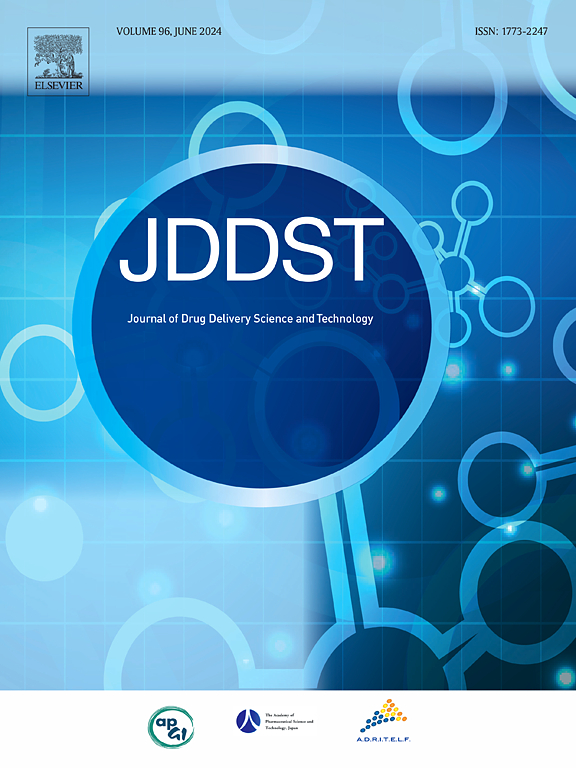An in-silico, in-vitro, and in-vivo analysis of hyaluronic acid embedded fucoidan capped silver nanoparticles against periodontal pathogen
IF 4.5
3区 医学
Q1 PHARMACOLOGY & PHARMACY
Journal of Drug Delivery Science and Technology
Pub Date : 2025-06-30
DOI:10.1016/j.jddst.2025.107228
引用次数: 0
Abstract
Increasing prevalence of antibiotic resistance among Periodontitis (PDs)-associated microbes poses a significant concern to treatment. Resistance mechanisms, including biofilm and β-lactamase production, hinder disease management. Silver nanoparticles (AgNPs) have been widely explored due to their broad-spectrum antimicrobial properties against resistant microbes. Microbial colonization and the complexity of biofilm in dentin canals limit the permeability of AgNPs and their efficacy. Biosurfactant-mediated AgNPs hold great potential for treating PD-associated infections. In this study, Staphylococcus aureus (S. aureus) was isolated from PDs patients, identified, and characterized by molecular sequencing. AgNPs were prepared using Fucoidan (FN), as it displayed higher binding affinity towards biofilm protein-bap (−3.965) and β- β-lactamase protein-AmpC (−4.331) of S. aureus. The AgNPs were further embedded with Hyaluronic acid (HA) to form a hydrogel matrix. The hydrogel was characterized using various analytical techniques such as UV, SEM, EDX, TEM, FTIR, DSC, DLS and XRD. Stabilized cubic-shaped FN-AgNPs (−36 mV) with a small diameter (85 ± 0.8 nm) exhibited good dispersion (FE-SEM) in HA-matrix and enhanced physicochemical properties. In-Vitro assays suggest the significant antimicrobial (MIC-62.5 μg/mL), antibiofilm (>80 %), and β-lactamase inhibition potential of HA-FN-AgNPs over NB-AgNPs (p ≤ 0.001) against S. aureus without marked cytotoxicity in HGF-1 (∼96 %). Further, In-Vivo findings revealed the superior antimicrobial efficacy, greater mucoadhesion (64 ± 0.56 %) and longer retention efficacy (up to 6 h) of the hydrogel with additional anti-inflammatory properties, suppressing the expression of proinflammatory cytokines (IL-6, IL-1β, and TNF-α), and enhanced drug delivery to PDs pocket. From this study, we conclude that FN-coated-AgNPs synthesized from U. pinnatifida have tremendous potential in drug development.

透明质酸包埋岩藻胶包覆的银纳米颗粒对牙周病原体的体内、体外和体内分析
牙周炎(pd)相关微生物中抗生素耐药性的增加对治疗提出了重大关注。抗性机制,包括生物膜和β-内酰胺酶的产生,阻碍了疾病的管理。银纳米颗粒(AgNPs)由于其对耐药微生物的广谱抗菌特性而被广泛探索。微生物定植和牙本质管中生物膜的复杂性限制了AgNPs的渗透性和有效性。生物表面活性剂介导的AgNPs在治疗pd相关感染方面具有很大的潜力。本研究从pd患者中分离金黄色葡萄球菌(S. aureus),通过分子测序对其进行鉴定和表征。利用岩藻聚糖(FN)制备AgNPs,发现其对金黄色葡萄球菌生物膜蛋白-bap(−3.965)和β- β-内酰胺酶蛋白- ampc(−4.331)具有较高的结合亲和力。AgNPs进一步嵌入透明质酸(HA)形成水凝胶基质。采用UV、SEM、EDX、TEM、FTIR、DSC、DLS、XRD等分析技术对水凝胶进行了表征。稳定的立方型FN-AgNPs(−36 mV)直径小(85±0.8 nm),在ha基体上具有良好的分散(FE-SEM)和增强的物理化学性能。体外实验表明,HA-FN-AgNPs比NB-AgNPs对金黄色葡萄球菌具有显著的抗菌(MIC-62.5 μg/mL)、抗菌膜(> 80%)和β-内酰胺酶抑制潜力(p≤0.001),而对HGF-1没有明显的细胞毒性(~ 96%)。此外,体内实验结果显示,该水凝胶具有较好的抗菌效果,更强的黏附(64±0.56%)和更长的滞留时间(长达6小时),具有额外的抗炎特性,抑制促炎细胞因子(IL-6、IL-1β和TNF-α)的表达,并增强药物向pd口袋的传递。本研究表明,从羽田菁中合成的fn包覆agnps具有巨大的药物开发潜力。
本文章由计算机程序翻译,如有差异,请以英文原文为准。
求助全文
约1分钟内获得全文
求助全文
来源期刊
CiteScore
8.00
自引率
8.00%
发文量
879
审稿时长
94 days
期刊介绍:
The Journal of Drug Delivery Science and Technology is an international journal devoted to drug delivery and pharmaceutical technology. The journal covers all innovative aspects of all pharmaceutical dosage forms and the most advanced research on controlled release, bioavailability and drug absorption, nanomedicines, gene delivery, tissue engineering, etc. Hot topics, related to manufacturing processes and quality control, are also welcomed.

 求助内容:
求助内容: 应助结果提醒方式:
应助结果提醒方式:


